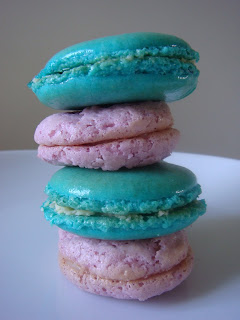
No, not triple x macarons (what on earth would those be like?) but three kinds of macarons for my triple x birthday! That's triple x as in Roman numerals - get your mind out of the gutter! :)
Yeah, the big day was Saturday, and I requested three kinds of macarons for the celebration with the parents. The flavors I came up with was an autumn-y apple-cinnamon-caramel, a sophisticated lavender-vanilla, and a fresh raspberry-lime.

Apple-Cinnamon-Caramel macarons
These are made by adding cinnamon to a normal almond shell recipe, and are filled with a combination of apple compote and caramel sauce. They taste like apple pie, with a slight burnt sugar note from the caramel.
Cinnamon macaron shells
100 g egg whites
30 g sugar
100 g ground almonds
200 g confectioner's sugar
dash of lemon juice
2 tsp cinnamon (heaped)
Sift the ground almonds and confectioner's sugar into a large bowl. Add the cinnamon and mix well. Whip the egg whites and lemon juice to a foam, add the sugar and whip it to a soft meringue. Fold the meringue into the dry mixture without overworking it. Pipe small rounds on a parchment covered baking sheet (use a round tip). Let them sit for at least 30 minutes before baking at 175°C for 7–8 minutes.
Apple compote
500 g apples
100 g sugar
20 g lemon juice (20 ml)
1 small cinnamon stick
Peel the apples and remove the cores. Slice them thinly and put in a pan together with sugar, lemon juice and a cinnamon stick. Boil on low heat until you have a thick compote. Let it cool completely. Remove the cinnamon stick, and use a mixer or an immersion blender to turn the compote into a smooth puree.
Caramel sauce
120 g sugar
1 tsp lemon Juice
300 g cream
Melt the sugar and lemon juice in a pan until you have a light brown caramel. Add the cream little by little and boil until the caramel is dissolved. Let it cool, transfer to an airtight container and store in the fridge. The sauce will thicken as it cools.
Assembly
Mix equal parts of apple compote and caramel sauce. Taste to see if you want more apple flavor, or more caramel. Spread the apple-caramel filling between the cinnamon macaron shells.

Lavender-Vanilla macarons
These are lavender flavored shells filled with French vanilla buttercream. The idea was to make them a soft, blueish color - like in the Swedish flag macarons - but we had forgotten how much food coloring to use... So: if you pour in one teaspoon of liquid blue food coloring, you will get these very bright, kind of turquoise colored macarons. Not what we aimed for, but at least the taste was delicious. Besides the somewhat in-your-face coloring, these were the macarons that ended up looking the best. Nice uniform size, perfect "feet", no "peaks".
Lavender macaron shells
Use the recipe above, but instead of cinnamon you add half a tablespoon of dried lavender. Bash the flowers up using a mortar and pestle before adding them to the almond-sugar mix. If you want to use blue food coloring to get a lavender-colored cookie (or a bright turquoise one!), you should add it while whipping the egg whites. (Note! That is if you use liquid food coloring - I have no experience using powders, but visit Tartelette for professional guidance.)
French vanilla buttercream
80 g egg yolks (about 4)
½ vanilla bean
60 g water (60 ml)
125 g sugar
250 g unsalter butter, at room temperature.
Whip the egg yolks until they are light colored and airy.
Split the vanilla bean, scrape out the seeds and put them in a small pan. Add water and sugar, and bring to a boil. Use a wet pastry brush to brush down the sides of the pan, this will remove any sugar crystals that have stuck there. Boil until a sugar thermometer reads 117°C.
Add the sugar mixture to the egg yolks, while whisking constantly.
Continue whisking until the mixture is cool. Add the butter little by little, and whisk until the buttercream is light and airy. The buttercream can be frozen.

Raspberry-Lime macarons
Here I want to quote the lady with the most mouth-watering blog of the pastry blogosphere, Tartelette. She has this to say about flavoring macaron shells:
One of the trickiest thing to do with macarons is to flavor the shells without messing up the texture. Adding liquid to the batter is to me like jumping off a plane wishing your parachute is going to work properly.Our parachute didn't work this time. Adding liquid has worked for us before, but this time, we got a visit from Murphy when trying to make raspberry flavored macarons using raspberry puree. The macarons ended up misshapen, and had a very unmacarony texture - more like a fluffy meringue. At least the flavor was great; they really taste of raspberries and despite their sad look I kind of fell in love with their girly pink color (helped by a drop or two of red food coloring).
I won't give you the recipe since they need to be perfected. For the lime curd, see this recipe for lemon curd, but use the zest of two limes and lime juice instead.

From top to bottom: good macaron, bad macaron, good macaron, bad macaron!










